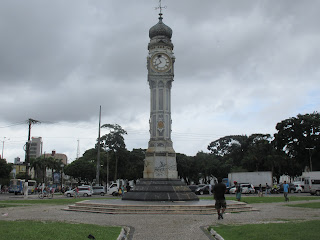Belem is the regional capital and largest city in Para state. It is 100kms up the Para River. It is often referred to as Cidade das Mangueiras, the City of Mango Trees due to the number of mangoes growing in the area, both in the jungle and throughout the city. They love the all year round warmth, the high rainfall and the humidity. Their ripe fruit falls to the pavements and makes them slippery.
The warm damp weather also allows grass and ferns to grow everywhere and out of every crack, whilst the humidity allows a host of green moss and algae to thrive and black mould to sprout everywhere. This also makes the paths slippery and means that even recently finished buildings soon became rather drab as natures greens and blacks take over.
Belem is acknowledged as the gateway to the Amazon although it is actually on the Para River. It is separated from the Amazon itself by Ihla de Marano, Marano Island which is the world's largest fluvial island, an island made completely out of river sediments. The city is 11th largest by population but only 16th by economic activity. It shows that the average per capita income is rather low for cities of a similar size.
Certainly moving around the city, there do seem to be a lot of run down areas, not helped by natures green and blacks growing everywhere even on up market buildings. The city has had a lot of rebuilding so there are isolated buildings from colonial or industrial times surrounded by modern buildings, not to mention detached house dwarfed by their high rise neighbours.
The first European buildings were started by the Portuguese. A fort was built here by Portuguese captain-general Francisco Caldeira Castelo Branco on 12th January 1612 to curb French Dutch and English trading. A colony sprung up next door.
The fort failed to stop the traders although the fort and the adjacent colony deterred the foreign traders from setting up their own colonies. However they set up further along the coast with French speaking Guiana with its capital of Cayenne known for its pepper, Dutch speaking Surinam and English speaking Guyana with its capital Georgetown known for its demarara sugar and for a while for its gold.
The original fort was wood but replaced with this stone fort just a few years later.
The guns were imported from UK, Whitworths, built in mid 19th century.
The view from the fort overlooking the original port and the fish market in the centre of the picture.
There are over 600 fish traded in the market which is colourful and surprising doesn't smell too bad!
An armoured fresh water fish.
Some views of the city.
The cathedral,
The pulpit and a view inside of the cathedral.
Th meat market which is a wonderful 19th century iron construction.
The iron work was imported from Scotland.
























No comments:
Post a Comment